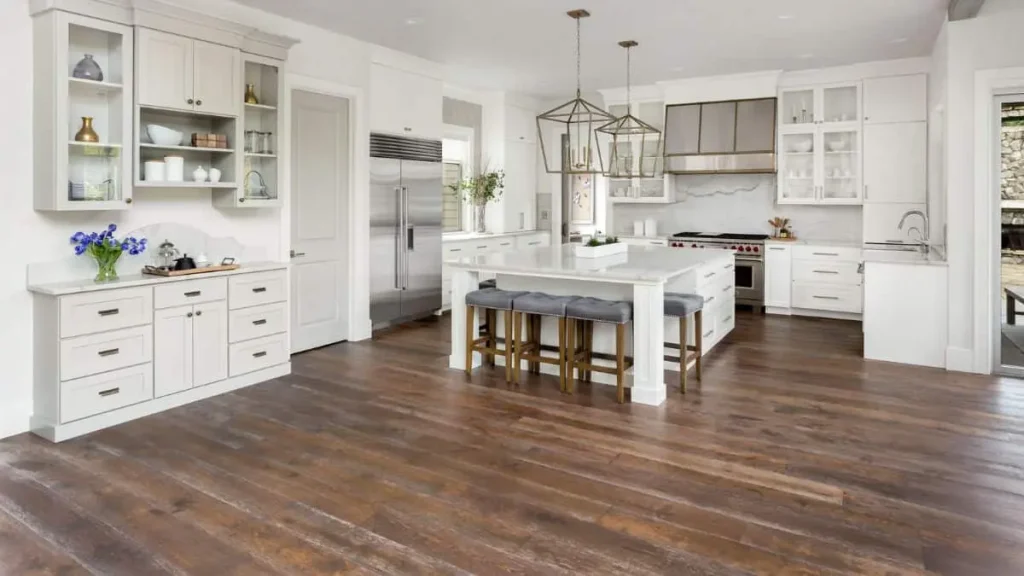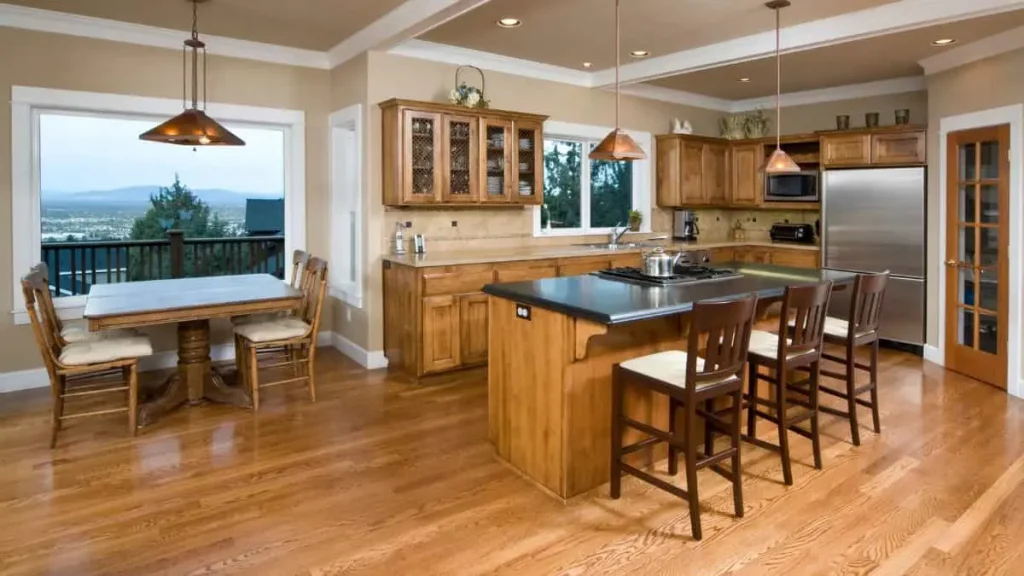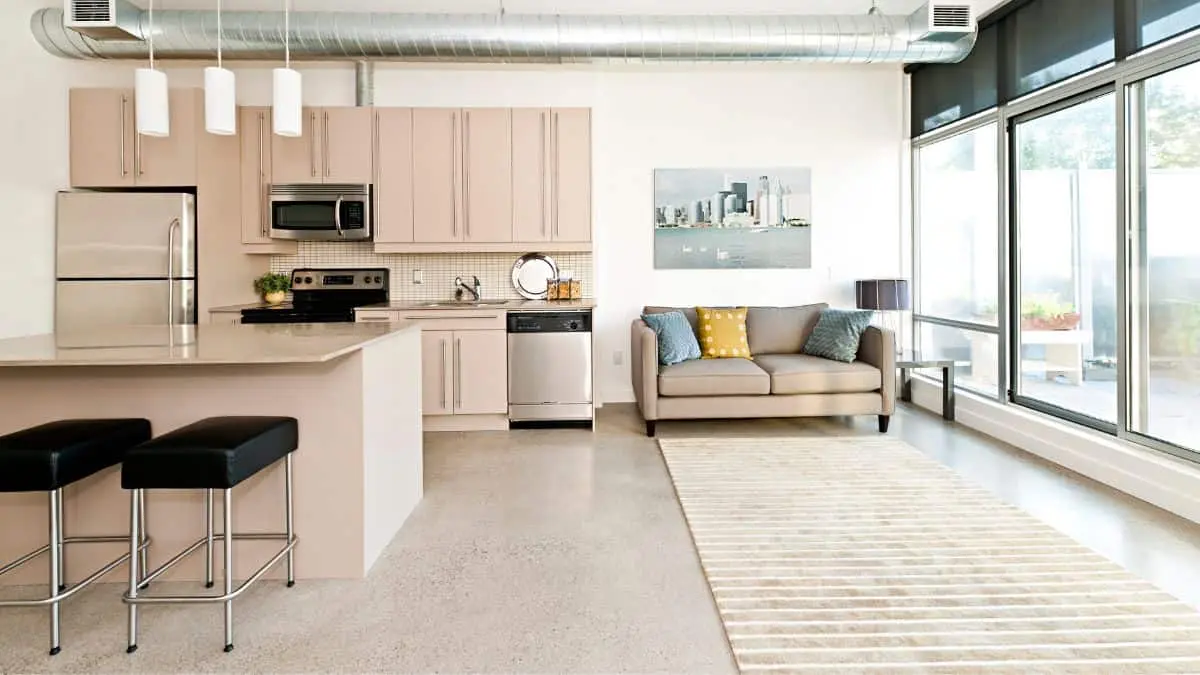For a seamless transition between the kitchen and living room in an open concept floor plan, consider using transition strips. Transition strips help connect different types of flooring for a cohesive look and added functionality.
By nailing or gluing them directly on the subfloor, you can create a stylish and smooth flow between the two spaces. Mixing flooring types can also be a creative choice, allowing for a unique design aesthetic in your home. Whether you opt for matching flooring or a blend of styles, the transition between rooms can be both practical and visually appealing.
Explore different flooring options, like laminate, to find the best fit for your open plan kitchen and living room design.
Benefits Of Open Concept Design
Open concept design has become a popular choice in modern homes due to its ability to create a sense of spaciousness, enhance functionality, and foster a more social and welcoming environment. Here’s how an open concept design transforms the flow and feel of a home:

Enhanced Sense of Space and Flow
One of the most immediate benefits of an open concept layout is the increased sense of space. Removing walls between the kitchen and living room opens up the area, allowing for an unobstructed view across multiple zones. This layout maximizes natural light flow, making each room appear brighter and more expansive. With fewer barriers, it becomes easier to transition from one activity zone to another, creating a harmonious flow that allows both family and guests to enjoy the home without feeling confined by walls.
Improved Social Interaction
An open concept design fosters a social atmosphere that encourages interaction, perfect for both everyday living and entertaining. By integrating the kitchen and living room, the cook can engage in conversation with guests or family members rather than being isolated. Whether it’s a casual family gathering, a holiday party, or just catching up with loved ones, an open floor plan allows everyone to be part of the same shared space, promoting stronger connections.
Greater Flexibility and Functionality
With an open concept layout, the space becomes highly adaptable, giving homeowners flexibility to arrange furniture and décor in ways that suit their lifestyle. The multifunctional nature of an open concept room means the kitchen can seamlessly flow into a dining area or a cozy living space, allowing for the addition of islands, bar seating, or extended dining tables without crowding the area. This flexibility also allows homeowners to rearrange furniture to suit changing needs or design preferences over time.
Improved Sightlines and Supervision
For families, the open concept design provides practical benefits in terms of visibility and supervision. Parents can keep an eye on children playing in the living room while preparing meals in the kitchen. This added visibility enhances safety and convenience, making it easy to check on everyone at a glance. Moreover, this layout creates sightlines that allow for unobstructed views through windows or into other areas of the home, making it feel both secure and connected to the outdoors.
Enhanced Light and Energy Efficiency
An open concept layout maximizes the reach of natural light, reducing the need for artificial lighting during the day. With fewer walls to block light, sunlight flows more freely throughout the space, illuminating areas that would otherwise require additional lighting. Not only does this create a bright, cheerful atmosphere, but it also helps in conserving energy and lowering electricity costs. Open concept designs can contribute to a more sustainable and efficient home environment.
Factors To Consider
When it comes to an open concept kitchen to living room floor transition, there are several factors to consider in order to achieve a seamless and visually appealing transition. From flooring options to color coordination, each aspect plays a crucial role in creating a cohesive and harmonious space. Let’s delve into the key factors to consider when transitioning between these two areas.
Flooring Options
When selecting flooring for the open concept kitchen and living room, it’s essential to choose materials that complement each other while serving their respective functions. Consider options such as:
- Hardwood: A timeless and elegant choice that adds warmth to the space.
- Tile: Durable and ideal for high-traffic areas like the kitchen.
- Laminate: Versatile and cost-effective, suitable for both areas.
Recommended Read: Budget-Friendly Kitchen Flooring Ideas
Color Coordination
Coordinating the colors of the flooring in the kitchen and living room is paramount to achieving a cohesive transition. Here are some tips for color coordination:
- Consistent Palette: Opt for a consistent color palette to create a seamless flow.
- Transition Piece: Utilize transition strips or thresholds that complement the flooring colors.
- Accent Rugs: Introduce accent rugs that tie in the color schemes of both areas.
Step-by-Step Installation Process

Creating a seamless floor transition between the kitchen and living room is essential in open-concept designs, as it unifies the space and enhances flow. Here’s how to achieve a professional, polished result:
1. Plan the Transition and Choose Flooring
- Choose Compatible Flooring: Opt for materials that work well together, such as hardwood, luxury vinyl plank (LVP), or tile, depending on durability and aesthetics.
- Decide on a Transition Style: Choose between a completely seamless transition (same flooring throughout) or a slight transition (using different flooring types but matching heights or adding a low-profile transition strip).
2. Prepare the Subfloor
- Check Subfloor Condition: Ensure the subfloor is level and smooth, as a consistent foundation is crucial for a seamless appearance.
- Fix any Imperfections: Sand down high spots and fill low spots using self-leveling compound to create a stable base for both flooring types, especially if they differ in thickness.
- Add Underlayment (if necessary): For floating floors, consider installing underlayment to reduce sound and add comfort. Check the manufacturer’s recommendations for both kitchen and living room floors.
3. Measure and Cut Flooring for a Perfect Fit
- Measure the Transition Line: If using different materials (e.g., tile in the kitchen and wood in the living room), measure precisely where the two will meet.
- Cut Flooring for an Exact Fit: Use a straight edge and cut each piece accurately to avoid gaps and create a tight fit between the two spaces. When installing tile, consider a tile spacer to maintain alignment.
4. Install the Flooring Starting from the Transition Point
- Work from the Seam Outward: Start at the transition line and work outward, ensuring the flooring flows naturally from the kitchen to the living room.
- Use Adhesive or Fasteners (as needed): Install each type of flooring according to the manufacturer’s instructions. For hardwood or LVP, interlock the planks tightly. For tile, use thin-set mortar and check each row for level alignment.
5. Secure a Smooth Transition with a Transition Strip (if needed)
- Select a Transition Strip for Different Flooring Heights: If there’s a height difference, a low-profile strip can create a smooth bridge between the two materials. Transition strips come in various styles, including T-molding, reducer, and flush stair nose, so choose one that complements your flooring.
- Install the Transition Strip: Attach the transition strip securely to the subfloor, ensuring it’s flush with both floors. This adds durability and reduces tripping hazards.
6. Seal the Transition for Durability
- Apply Sealant (if required): For tile-to-wood transitions, consider a silicone or flexible sealant in the seam to allow for expansion while keeping moisture out.
- Finish with Floor Protectant or Polish: Once installed, apply a protectant or polish suitable for the specific flooring materials, adding extra durability and shine.
7. Inspect and Make Final Adjustments
- Check for Smoothness and Stability: Walk across the transition to ensure it’s flush and stable, making any necessary adjustments to secure loose pieces.
- Inspect for Gaps: Fill any gaps with color-matched caulk or grout to maintain a seamless appearance, especially for tile-to-wood transitions.
Furniture Placement Tips
When it comes to an open concept kitchen to living room floor transition, furniture placement plays a crucial role in defining the space and ensuring a seamless flow. By strategically arranging your furniture, you can create distinct zones while maintaining an open and inviting atmosphere. Here are some furniture placement tips to help you make the most of your open floor plan.
Define Zones With Furniture
Create designated areas within the open space by using furniture to define different functions. For instance, position a sofa and coffee table to delineate the living room area, while placing a dining table and chairs to mark the dining space. This approach not only organizes the layout but also enhances the visual appeal of the entire area.
Avoid Blocking Pathways
Maintain clear pathways between the kitchen and living room to ensure smooth traffic flow. Avoid placing large furniture pieces in the middle of the floor transition, as this can disrupt the visual continuity and impede movement. Opt for streamlined and versatile furniture that allows for easy navigation throughout the space.
Popular Design Trends
An open concept floor plan is a popular design trend that has gained significant traction in recent years. It seamlessly integrates the kitchen and living room, creating a cohesive and spacious living area. This concept allows for a smooth transition between the two spaces, offering a functional and aesthetically pleasing layout.
Industrial Chic
The industrial chic design trend embraces raw and unfinished elements, such as exposed brick, concrete floors, and metal accents. When applied to the transition between the kitchen and living room, industrial chic flooring choices like polished concrete or distressed hardwood can create a seamless flow, adding a touch of urban sophistication to the space.
Scandinavian Minimalism
Scandinavian minimalism emphasizes simplicity, functionality, and natural elements. In an open concept layout, light-colored hardwood or laminate flooring can be used to achieve a seamless transition while maintaining the clean, uncluttered aesthetic characteristic of Scandinavian design.
Personalizing The Space
When it comes to an open concept kitchen to living room floor transition, personalizing the space is essential to create a cohesive and inviting atmosphere. Incorporating personal touches and showcasing artwork can elevate the overall design and reflect your unique style and personality.
Incorporating Personal Touches
Adding personal touches to the transition area can make it feel more connected and integrated with the rest of the living space. Consider incorporating elements that resonate with your personal style, such as:
- Customized area rugs or runners to add warmth and comfort
- Personalized wall decor or family photographs to infuse sentimental value
- Distinctive lighting fixtures to create ambiance and visual interest
Showcasing Artwork
Displaying artwork can serve as a focal point and contribute to the overall aesthetic appeal of the open concept area. Here are some ideas for showcasing artwork in the transition space:
- Gallery wall featuring a curated collection of paintings or photographs
- Sculptures or art installations to add dimension and character
- Statement pieces that complement the color scheme and design theme
Conclusion
Creating a seamless transition between your open concept kitchen and living room floor is crucial for a cohesive design. By considering the best flooring options and using transition strips strategically, you can achieve a stylish and functional space that flows effortlessly.
Embrace creativity in your design choices!



